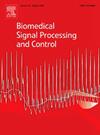Spatio-temporal graph Bert network for EEG emotion recognition
IF 4.9
2区 医学
Q1 ENGINEERING, BIOMEDICAL
引用次数: 0
Abstract
EEG data presents a topological structure in spatial. In order to effectively capture the temporal and spatial characteristics of brain data, this paper proposes a Spatio-temporal Graph Bert network (STGB) and applies it to the emotion recognition of Electroencephalogram (EEG) signals. The STGB network learns the EEG features from the spatial and the temporal domains respectively. In the spatial domain, the adjacency matrix is constructed to model the graph of EEG signals, and then the spatial domain features of EEG signals are extracted by using the Graph Bert network through the steps of subgraph partitioning, node embedding, node feature updating based on attention mechanism and node clustering. In the temporal domain, the spatial domain features of EEG signals obtained from each period are connected by the Long Short-Term Memory network (LSTM) to learn the temporal correlation of the EEG signals, so as to complete the EEG emotion recognition task. Experiments on SEED dataset and DEAP dataset prove that STGB can complete the learning of EEG features more comprehensively and accurately, and achieve a higher emotion recognition rate.
求助全文
约1分钟内获得全文
求助全文
来源期刊

Biomedical Signal Processing and Control
工程技术-工程:生物医学
CiteScore
9.80
自引率
13.70%
发文量
822
审稿时长
4 months
期刊介绍:
Biomedical Signal Processing and Control aims to provide a cross-disciplinary international forum for the interchange of information on research in the measurement and analysis of signals and images in clinical medicine and the biological sciences. Emphasis is placed on contributions dealing with the practical, applications-led research on the use of methods and devices in clinical diagnosis, patient monitoring and management.
Biomedical Signal Processing and Control reflects the main areas in which these methods are being used and developed at the interface of both engineering and clinical science. The scope of the journal is defined to include relevant review papers, technical notes, short communications and letters. Tutorial papers and special issues will also be published.
 求助内容:
求助内容: 应助结果提醒方式:
应助结果提醒方式:


